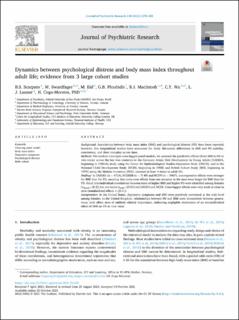| dc.contributor.author | Scarpato, B.S. | |
| dc.contributor.author | Swardfager, W. | |
| dc.contributor.author | Eid, M. | |
| dc.contributor.author | Ploubidis, G.B. | |
| dc.contributor.author | MacIntosh, B.J. | |
| dc.contributor.author | Wu, C.Y. | |
| dc.contributor.author | Launer, L.J. | |
| dc.contributor.author | Cogo-Moreira, H. | |
| dc.date.accessioned | 2022-01-24T09:00:41Z | |
| dc.date.available | 2022-01-24T09:00:41Z | |
| dc.date.created | 2021-12-03T13:01:36Z | |
| dc.date.issued | 2021 | |
| dc.identifier.citation | Journal of Psychiatric Research. 2021, 144, 378-388. | en_US |
| dc.identifier.issn | 0022-3956 | |
| dc.identifier.uri | https://hdl.handle.net/11250/2838863 | |
| dc.description.abstract | Background: Associations between body mass index (BMI) and psychological distress (PD) have been reported; however, few longitudinal studies have accounted for likely life-course differences in BMI and PD stability, consistency, and their interplay across time.
Methods: Via random intercepts cross-lagged panel models, we assessed the predictive effects (from BMI to PD or vice-versa) across the last two centuries in the Coronary Artery Risk Development in Young Adults [CARDIA, beginning in 1985-6] study using the Center for Epidemiological Studies-Depression Scale [CES-D], and in the National Child Development Study [NCDS, beginning in 1958] and British Cohort Study [BCS, beginning in 1970] using the Malaise Inventory [MI]), assessed at least 4 times in adult life.
Findings: In CARDIA (n = 4724), NCDS58 (n = 7149) and BCS70 (n = 5967), autoregressive effects were stronger for BMI than for PD, meaning that carry-over effects from one occasion to the next were larger for BMI than for PD. Small interindividual correlations between traits of higher BMI and higher PD were identified among females (rfemale<|0⋅2|) but not males (rmale<|0⋅03|) in CARDIA and NCDS. Cross-lagged effects were very weak or close to zero (standardized effects η<|0⋅1|).
Interpretation: In the United States, depressive symptoms and BMI were positively correlated at the trait level among females. In the United Kingdom, relationships between PD and BMI were inconsistent between generations, with effect sizes of unlikely clinical importance, indicating negligible dominance of an intraindividual effect of BMI on PD or vice versa. | en_US |
| dc.language.iso | eng | en_US |
| dc.publisher | Elsevier | en_US |
| dc.rights | Navngivelse 4.0 Internasjonal | * |
| dc.rights.uri | http://creativecommons.org/licenses/by/4.0/deed.no | * |
| dc.subject | cross-lag panel model | en_US |
| dc.subject | body mass index | en_US |
| dc.subject | depressive symptoms | en_US |
| dc.subject | psychological distress | en_US |
| dc.subject | birth cohort | en_US |
| dc.title | Dynamics between psychological distress and body mass index throughout adult life; evidence from 3 large cohort studies | en_US |
| dc.type | Peer reviewed | en_US |
| dc.type | Journal article | en_US |
| dc.description.version | publishedVersion | en_US |
| dc.rights.holder | © 2021 The Authors. | en_US |
| dc.subject.nsi | VDP::Medisinske Fag: 700::Klinisk medisinske fag: 750::Psykiatri, barnepsykiatri: 757 | en_US |
| dc.source.pagenumber | 378-388 | en_US |
| dc.source.volume | 144 | en_US |
| dc.source.journal | Journal of Psychiatric Research | en_US |
| dc.identifier.doi | 10.1016/j.jpsychires.2021.10.030 | |
| dc.identifier.cristin | 1964294 | |
| cristin.ispublished | true | |
| cristin.fulltext | original | |
| cristin.qualitycode | 1 | |

